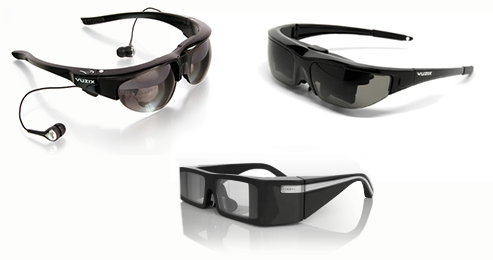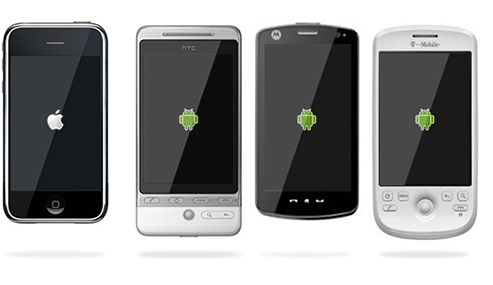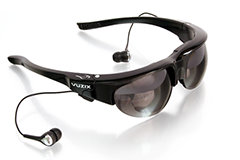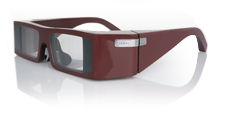Eye for an iPhone
 Sunday, September 20, 2009 at 2:09PM
Sunday, September 20, 2009 at 2:09PM This article picks up from my last piece, “Terminator Vision.”
Eyeglasses, as we know them today, have been around for about 800 years, give or take. In-eye lenses, for just over a hundred and modern contact lens for about 50. In our time of exponential technological advancement I don’t expect to wait half a century for this technology to mature, but we’re going to see augmented reality optics in a form-factor similar to eyeglasses long before we’re placing them directly onto our cornea.
I do, however, believe that the “through the looking glass” trend of AR applications for mobile devices that are coming on the market today will be a short lived, stop-gap solution until the adoption of AR eyewear. If mobile AR indeed takes off (and I believe it will), people will quickly tire of holding their smartphones out in front of their faces. This will ultimately lead to interesting partnerships between fashion eyewear manufactures and consumer electronics companies, not unlike the partnership between Nike and Apple in the personal fitness electronics space. For now we have several electronic manufactures, many who are most use to dealing with military clients, doing their best to design consumer focussed video eyewear. With mixed results.

Vuzix, the only manufacturer already in the market with a consumer level AR offering, is due to launch two new stereoscopic pairs with AR functionality before the holidays (Wrap 920 and Wrap 310 shown on top row, above). The launch date was moved back once, the 920s were originally planned for a Spring debut. Vuzix technology is similar to that used in standard video eyewear, but an attachment will add cameras to “see” in front of the lens, and play the camera’s video feed with data overlaid— not dissimilar to the AR apps currently available on the Android and iPhone now.
This is also the method that had been employed most extensively for augmented reality in commercial and research environments. WorldViz sells a VideoVision attachment for the NVIS nVisor. While these are state of the art in the AR eyewear space, the attachment alone costs about $12,000.00, and this does not include the NVIS unit which itself cost between $20,000.00 to $30,000.00, depending on the model. And neither price includes the software to run this rig. That’ll cost you extra. Sensics also has a commercial-grade offer in this space. While I don’t know anything about their pricing, I can vouch that they are equally as fashionable:

Besides their, um… avant garde styling, what distinguishes the Sensics and WorldViz/NVIS units from consumer-grade offerings is that both of these models display in HD. The experience is immersive. If you’ve ever played with regular (non-AR) video eyewear (whether 3D stereoscopic or simply 2D video glasses), you’re likely aware of the disappointing resolution. In the sub-$750 market, 640x480 is still standard fair. If you’re willing to spring for $1000+, then 800x600 is the top end of the consumer market. Resolution for the Vuzix Wrap models has not yet been disclosed (nor has the price), but I speculate that they will likely be 800x600.

Recent advancements by OEMs like Kopin (supplier to Vuzix, MyVu and others) and eMagin have increased microdisplay resolutions up to 1280x1024 on screens smaller than 1 inch. Both are now offering paired assemblies for stereoscopic eyewear. Kopin is actively seeking partnerships to take their newest technology to market in consumer products, while eMagin maintains their own consumer devision (branded 3Dvisor), marketing HMDs for the gaming market.
While there are many industrial applications for this technology in the fields of architecture/engineering, aviation and other training environments (not to mention entertainment/gaming), most of this research has been funded by military contracts. Peter Wood, a CD I worked with in the past, once said, “How great it would be if we could gain all the technological advances of World War III without having to fight it.” At risk of opening a debate over military policy, the reality is that (as has always been the case) a great number of recent technological advancements spring from research initially financed by military contracts and military related research. Indeed, as with most of these companies, Kopin’s largest clients are US military contractors.
What I find most interesting in this space is that, much like the market in TV displays, there are currently many different technologies emerging that are going to compete with one another. This should be a boon for the consumer— resulting in faster innovation and lowering costs.

Lumus Optical has another approach. Lumus, the Israeli supplier of military video components, has engineered a solution that projects a partially translucent image onto the inside of a specially designed eyeglass lens. The model (shown at top with the two Vuzix models) is a functional concept pair. Lumus is attempting to partner with consumer retailer who could buy the lens assembly, and incorporate it into their own form-factor.

In 2008 Apple was awarded a patent for a translucent augmented reality eyewear design that cleverly employs prisms and mirrors to move a laser projection from between the lens, and cast it onto the lens facing the eye. Apple, true to its culture, has not said a word about the filing or any forthcoming products employing such technology.
Microvision, manufacturer of laser pico-projector components, has also been awarded video vision patents, theirs for retinal laser scanner technology, over a decade ago now. With an existing clientele primarily in military suppliers, their pico-projectors have begun making inroads into consumer mobile devices. Perhaps encouraged by this consumer market success, they are aggressively seeking partners to take their eyewear technology into the consumer space.
Another technology with tremendous promise is transparent (and flexible) OLED. Everyone from Samsung to GE to Kadak to Philips and others have been experimenting with lightweight, flexible and transparent OLEDs. The potential here is obvious, as it is not difficult to imagine simply building a transparent curved OLED into the lens of a pair of glasses, obviating the need for much of the engineering gymnastics required to get the other display types in front of the eye without creating unnecessary bulk and obstruction. Thus far I’ve not seen a single prototype employing this technique, though the Samsung representative touting the technology in the video (below) made at the 2009 CES does mention it as a possible application. The second video is a demonstration by Sony of the malleability of their flexible OLED.
Unlike some other overhyped memes of the moment, these are proven technologies, some of which are already on the market, others that we can expect to see on the market in the next 12 to 24 months.
To read about the evolution of Virtual Reality eyewear, with an overview of virtual world marketing techniques, read the GigantiCo article, “Virtual Reality: Part 1”.
 Augmented Reality in
Augmented Reality in  Technology
Technology 




 next several months multiple vendors will be introducing new models, and Google
next several months multiple vendors will be introducing new models, and Google 

 The
The  If the quality of the user experience fails to live up to expectations, Vuzix has many pretenders to the crown. Fast followers like
If the quality of the user experience fails to live up to expectations, Vuzix has many pretenders to the crown. Fast followers like 







